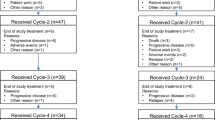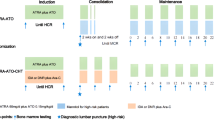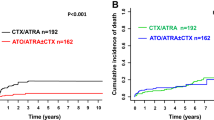Abstract
The purpose of our study was (i) to evaluate the impact of all-trans retinoic acid (ATRA) given as adjunct to chemotherapy and (ii) to compare second consolidation vs maintenance therapy in elderly patients with acute myeloid leukemia (AML). A total of 242 patients aged ⩾61 years (median, 66.6 years) with AML were randomly assigned to ATRA beginning on day +3 after the initiation of chemotherapy (ATRA-arm, n=122) or no ATRA (standard-arm, n=120) in combination with induction and first consolidation therapy. A total of 61 patients in complete remission (CR) were randomly assigned to second intense consolidation (n=31) or 1-year oral maintenance therapy (n=30). After induction therapy the intention-to-treat analysis revealed a significant difference in CR rates between the ATRA- and the standard-arm (52 vs 39%; P=0.05). Event-free (EFS) and overall survival (OS) were significantly better in the ATRA-compared to the standard-arm (P=0.03 and 0.01, respectively). OS after second randomization was significantly better for patients assigned to intensive consolidation therapy (P<0.001). The multivariate model for survival revealed lactate dehydrogenase, cytogenetic risk group, age, and first and second randomization as prognostic variables. In conclusion, the addition of ATRA to induction and consolidation therapy may improve CR rate, EFS and OS in elderly patients with AML.
This is a preview of subscription content, access via your institution
Access options
Subscribe to this journal
Receive 12 print issues and online access
$259.00 per year
only $21.58 per issue
Buy this article
- Purchase on Springer Link
- Instant access to full article PDF
Prices may be subject to local taxes which are calculated during checkout


Similar content being viewed by others
References
Mayer RJ, Davis RB, Schiffer CA, Berg DT, Powell BL, Schulman P et al. Intensive post remission chemotherapy in adults with acute myeloid leukemia. N Engl J Med 1994; 331: 896–903.
Stone RM, Berg DT, George SL, Dodge RK, Paciucci PA, Schulman P et al. Granulocyte–macrophage colony-stimulating factor after initial chemotherapy for elderly patients with primary acute myelogenous leukaemia. Cancer and Leukemia Group B. N Engl J Med 1995; 332: 1671–1677.
Rowe JM, Andersen JW, Mazza JJ, Bennett JM, Paietta E, Hayes FA et al. A randomized placebo-controlled phase III study of granulocyte–macrophage colony-stimulating factor in adult patients (>55–70 years of age) with acute myelogenous leukemia: a study of the Eastern Cooperative Oncology Group (E1490). Blood 1995; 86: 457–462.
Lowenberg B, Suciu S, Archimbaud E, Ossenkoppele G, Verhoef GE, Vellenga E et al. Use of recombinant granulocyte–macrophage colony-stimulating factor during and after remission induction chemotherapy in patients aged 61 years and older with acute myeloid leukemia (AML): final report of AML-11, a phase III randomized study of the Leukemia Cooperative Group of European Organisation for the Research and Treatment of Cancer (EORTC-LCG) and the Dutch Belgian Hemato-Oncology Cooperative Group (HOVON). Blood 1997; 90: 2952–2961.
Godwin JE, Kopecky KJ, Head DR, Willman CL, Leith CP, Hynes HE et al. A double-blind placebo-controlled trial of granulocyte colony-stimulating factor in elderly patients with previously untreated acute myeloid leukemia: a Southwest Oncology Group study (9031). Blood 1998; 91: 3607–3615.
Goldstone AH, Burnett AK, Wheatley K, Smith AG, Hutchinson RM, Clark RE, Medical Research Council Adult Leukemia Working Party. Attempts to improve treatment outcomes in acute myeloid leukemia (AML) in older patients: the results of the United Kingdom Medical Research Council AML11 trial. Blood 2001; 98: 1302–1311.
Baer MR, George SL, Dodge RK, O'Loughlin KL, Minderman H, Caligiuri MA et al. Phase 3 study of the multidrug resistance modulator PSC-833 in previously untreated patients 60 years of age and older with acute myeloid leukemia: Cancer and Leukemia Group B Study 9720. Blood 2002; 100: 1224–1232.
Schiffer CA, Lee EJ, Tomiyasu T, Wiernik PH, Testa JR . Prognostic impact of cytogenetic abnormalities in patients with de novo acute nonlymphocytic leukemia. Blood 1989; 73: 263–270.
Dastugue N, Payen C, Lafage-Pochitaloff M, Bernard P, Leroux D, Huguet-Rigal F et al. Prognostic significance of karyotype in de novo adult acute myeloid leukemia. The BGMT group. Leukemia 1995; 9: 1491–1498.
Leith CP, Kopecky KJ, Godwin J, McConnell T, Slovak ML, Chen IM et al. Acute myeloid leukemia in the elderly: assessment of multidrug resistance (MDR1) and cytogenetics distinguishes biologic subgroups with remarkably distinct responses to standard chemotherapy. A Southwest Oncology Group study. Blood 1997; 89: 3323–3329.
Hoyle CF, de Bastos M, Wheatley K, Sherrington PD, Fischer PJ, Rees JK et al. AML associated with previous cytotoxic therapy, MDS or myeloproliferative disorders: results from the MRC's 9th AML trial. Br J Haematol 1989; 72: 45–53.
Campos L, Rouault JP, Sabido O, Oriol P, Roubi N, Vasselon C et al. High expression of bcl-2 protein in acute myeloid leukemia cells is associated with poor response to chemotherapy. Blood 1993; 81: 3091–3096.
Maung ZT, MacLean FR, Reid MM, Pearson AD, Proctor SJ, Hamilton PJ et al. The relationship between bcl-2 expression and response to chemotherapy in acute leukaemia. Br J Haematol 1994; 88: 105–109.
Karakas T, Miething CC, Maurer U, Weidmann E, Ackermann H, Hoelzer D et al. The coexpression of the apoptosis-related genes bcl-2 and wt1 in predicting survival in adult acute myeloid leukemia. Leukemia 2002; 16: 846–854.
Del Poeta G, Venditti A, Del Principe MI, Maurillo L, Buccisano F, Tamburini A et al. Amount of spontaneous apoptosis detected by BAX/Ccl-2 ratio predicts outcome in acute myeloid leukemia (AML). Blood 2003; 101: 2125–2131.
Hu ZB, Minden MD, McCulloch EA . Direct evidence for the participation of bcl-2 in the regulation by retinoic acid of the Ara-C sensitivity of leukemic stem cells. Leukemia 1995; 9: 1667–1673.
Bradbury DA, Aldington S, Zhu YM, Russell NH . Down-regulation of bcl-2 in AML blasts by all-trans retinoic acid and its relationship to CD34 antigen expression. Br J Haematol 1995; 94: 671–675.
Benito A, Grillot D, Nunez G, Fernandez-Luna JL . Regulation and function of Bcl-2 during differentiation-induced cell death in HL-60 promyelocytic cells. Am J Pathol 1995; 146: 481–490.
Yang GS, Minden MD, McCulloch EA . Influence of schedule on regulated sensitivity of AML blasts to cytosine arabinoside. Leukemia 1993; 7: 1012–1019.
Zheng A, Mantymaa P, Saily M, Siitonen T, Savolainen ER, Koistinen P . p53 pathway in apoptosis induced by all-trans-retinoic acid in acute myeloblastic leukaemia cells. Acta Haematol 2000; 103: 135–143.
Andreeff M, Jiang S, Zhang X, Konopleva M, Estrov Z, Snell VE et al. Expression of Bcl-2-related genes in normal and AML progenitors: changes induced by chemotherapy and retinoic acid. Leukemia 1999; 13: 1881–1892.
Ketley NJ, Allen PD, Kelsey SM, Newland AC . Modulation of idarubicin-induced apoptosis in human acute myeloid leukemia blasts by all-trans retinoic acid, 1,25(OH)2 vitamin D3, and granulocyte–macrophage colony-stimulating factor. Blood 1997; 90: 4578–4587.
Venditti A, Stasi R, Del Poeta G, Buccisano F, Aronica G, Bruno A . All-trans retinoic acid and low-dose cytosine arabinoside for the treatment of ‘poor prognosis’ acute myeloid leukemia. Leukemia 1995; 9: 1121–1125.
Hartmann F, Jacobs G, Gotto H, Schwamborn J, Pfreundschuh M . Cytosine arabinoside, idarubicin and divided dose etoposide for the treatment of acute myeloid leukemia in elderly patients. Leuk Lymphoma 2001; 42: 347–355.
Bennett JM, Catovsky D, Daniel MT, Flandrin G, Galton DA, Gralnick HR . Proposed revised criteria for the classification of acute myeloid leukemia. Ann Intern Med 1985; 103: 626.
Mitelman F (ed). ISCN: An International System for Human Cytogenetic Nomenclature. Basel, Switzerland: Karger, 1995.
Chen GQ, Shen ZX, Wu F, Han JY, Miao JM, Zhong HJ . Pharmacokinetics and efficacy of low-dose all-trans retinoic acid in the treatment of acute promyelocytic leukemia. Leukemia 1996; 10: 825–828.
Schlenk RF, Hartmann F, Hensel M, Jung W, Weber-Nordt R, Gabler A . Less intense conditioning with fludarabine, cyclophosphamide, idarubicin and etoposide (FCIE) followed by allogeneic unselected peripheral blood stem cell transplantation in elderly patients with leukemia. Leukemia 2002; 16: 581–586.
Cheson BD, Cassileth PA, Head DR, Schiffer CA, Bennett JM, Bloomfield CD . Report of the National Cancer Institute-sponsored workshop on definitions of diagnosis and response in acute myeloid leukemia. J Clin Oncol 1990; 8: 813–819.
Gray RJ . A class of k-sample tests for comparing the cumulative incidence of a competing risk. Ann Stat 1988; 16: 1141–1154.
Korn EL . Censoring distributions as a measure of follow-up in survival analysis. Stat Med 1986; 5: 255–260.
Andersen P, Gill RD . Cox's regression model for counting processes: a large sample study. Ann Stat 1982; 10: 1100–1120.
Ihaka R, Gentleman RR . A language for data analysis and graphics. J Comput Graph Stat 1996; 5: 299–314.
Harrell FE . Regression Modeling Strategies: With Applications to Linear Models, Logistic Regression, and Survival Analysis. Springer Verlag: New York, 2001.
Grimwade D, Walker H, Harrison G, Oliver F, Chatters S, Harrison CJ, et al, Medical Research Council Adult Leukemia Working Party. The predictive value of hierarchical cytogenetic classification in older patients with acute myeloid leukaemia (AML): analysis of 1065 patients entered into the United Kingdom Medical Research Council AML11 trial. Blood 2001; 98: 1312–1320.
Hu ZB, Minden MD, McCulloch EA . Phosphorylation of BCL-2 after exposure of human leukemic cells to retinoic acid. Blood 1998; 92: 1768–1775.
Carter BZ, Milella M, Altieri DC, Andreeff M . Cytokine-regulated expression of survivin in myeloid leukemia. Blood 2001; 97: 2784–2790.
Estey EH, Thall PF, Pierce S, Cortes J, Beran M, Kantarjian H et al. Randomized phase II study of fludarabine+cytosine arabinoside+idarubicin+/−all-trans retinoic acid+/−granulocyte colony-stimulating factor in poor prognosis newly diagnosed acute myeloid leukemia and myelodysplastic syndrome. Blood 1999; 93: 2478–2484.
Bolanos-Meade J, Karp JE, Guo C, Sarkodee-Adoo CB, Rapoport AP, Tidwell ML et al. Timed sequential therapy of acute myelogenous leukemia in adults: a phase II study of retinoids in combination with the sequential administration of cytosine arabinoside, idarubicin and etoposide. Leuk Res 2003; 27: 313–321.
Acknowledgements
We gratefully acknowledge Brigitte Schreiter and Christa Wieland for technical assistance. This work was supported by Grant 01GI9981 from the Bundesministerium für Bildung und Forschung (Kompetenznetz ‘Akute und chronische Leukämien’), Germany.
Author information
Authors and Affiliations
Consortia
Corresponding author
Rights and permissions
About this article
Cite this article
Schlenk, R., Fröhling, S., Hartmann, F. et al. Phase III study of all-trans retinoic acid in previously untreated patients 61 years or older with acute myeloid leukemia. Leukemia 18, 1798–1803 (2004). https://doi.org/10.1038/sj.leu.2403528
Received:
Accepted:
Published:
Issue Date:
DOI: https://doi.org/10.1038/sj.leu.2403528
Keywords
This article is cited by
-
Generation of a new therapeutic d-peptide that induces the differentiation of acute myeloid leukemia cells through A TLR-2 signaling pathway
Cell Death Discovery (2024)
-
Randomized phase-III study of low-dose cytarabine and etoposide + /− all-trans retinoic acid in older unfit patients with NPM1-mutated acute myeloid leukemia
Scientific Reports (2023)
-
All-trans retinoic acid enhances the cytotoxic effect of decitabine on myelodysplastic syndromes and acute myeloid leukaemia by activating the RARα-Nrf2 complex
British Journal of Cancer (2023)
-
Validating the knowledge bank approach for personalized prediction of survival in acute myeloid leukemia: a reproducibility study
Human Genetics (2022)
-
Overcoming microenvironment-mediated protection from ATRA using CYP26-resistant retinoids
Leukemia (2020)



